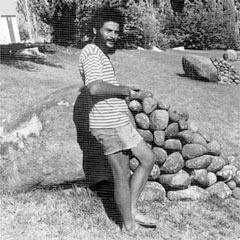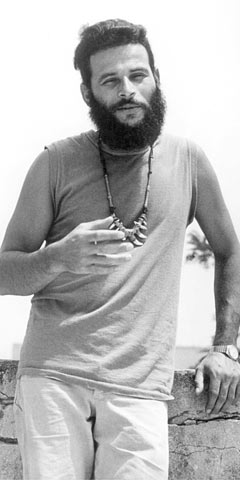|
Rough-hewn stone slabs yoked to supporting cedar poles, fur and rope meshed together, leather thongs that lure the senses and awake memories of raw rock, trees, wild creatures, the earth itself, are the materials of these works. Shaped by Vaadia, they evoke, too, the earliest expressions of human beings - ceremonial objects, tools, and rudimentary structures. Particularly striking about Vaadia's current work is the directness with which these pieces communicate a sense of involvement with primal forces without demanding initiation into a private magical ritual for complete understanding. This directness, this lean unadorned statement of both observance and encounter with his materials, is the result of a mediated decision made by Vaadia roughly three years ago, although in the full context of his development it must be seen as one aspect of a deep commitment evident many years ago. "A show gives me the chance to stand back to see my own works in perspective." So it was that after his show at Hundred Acres Gallery in 1976, Vaadia took the measure of his imagery and began to extend his search. At that time, every piece clearly affirmed the role of primitive art as the catalyst for his own aesthetic. By then he had cut all ties with conventions of western classical traditions (and had, as well, detatched himself from the highly stylized intellectual primitivism of much Surrealist vocabulary). In this first one-man show in the United States, Isreali-born Vaadia seemed to declare himself the heir only of early tribal artists; some critics then referred his work back to that of the American Indian. Without exception, the works in the 1976 show were structured to imply ceremonial objects. Usually marked with engraved symbols, the stones, sometimes marvelously contoured by nature, had the quality of highly charged sacred objects. They proclaimed an attatchment to early ritual, magic, and mystery. For Vaadia, each element in these earlier works was testimony to a profound personal connection with innate forces in those materials. The stones, marked with symbols and feathered decorations, existed on four-legged pedestals recalling the place of an alter. To see these pieces was to acknowledge another context of meaning different from that of this time and society and to be given the possibility of empathizing with ancient rites and rituals.
Vaadia himself speaks of the decision to introduce a new dynamic into the structure of his works, to move beyond the relatively static four-posted support system of the earlier works to a probing exploration of the lever, that most basic means of moving weight, of bringing about change, of position, of initiating movement. In so doing, he has become an active partner with the rocks, tree limbs, and resilient bindings. This is an act of animation that elicits a sense of sheer physical reality quite different in quality from the magical overtones of the earlier, more overtly primitive work. Weight, gravity, tension, suspension are experienced forces in nature and are key elements in Vaadia's current works. In each case, the human power to work with these elemental natural powers is affirmed by the scale of the works themselves: human in scale, not overpowering. This combination of potential power and approachability ties these works to the very beginnings of Vaadia's own encounter with nature. Raised on a farm in Isreal, Vaadia worked with the earth, built with stone and wood, carved his earliest drawings within a cave in the woods. Then, as a child, he was at home with these powers that have manifested themselves in curious guises as he has searched. For Vaadia, this commitment to a sense of immanent potency in the materials of nature has been a constant guide, attracting him in early youth to kindred expressions, primitive masks and fetishes. Later, after a period of academic training, it forced a series of experiments with synthetic materials that culminated ultimately in an affirmation of his own deep need to work directly with the materials of nature. There is another dimension to be reckoned with, too. It is not sufficient to think of Vaadia's current works as attached only to the environment of woods, streams, or farmlands. This group of recent works is made of materials drawn from the environment of New York City. The cedar poles that support his slabs of stone are the poles that support the saplings planted on city streets. The slabs of granite and limestone were first shaped as pavement, curbstones, or window ledges - shaped, moved, and placed in the building of a city. In maintaining a semblance of the square and rectangular man-made shapes of these building elements, Vaadia affirms that the human creature, like wind and rain and the seasons, is also a force in nature. But in drawing from these building blocks the raw substance of the material itself, he speaks about primary sources. © 1979 Julia Keydel
|
 The power of natural materials and the relation of human beings to that power determine
the content of Boaz Vaadia's sculpture. This is sculpture which celebrates primary experiences.
Untitled, offering no verbal suggestion of hidden meanings or pretensions to intellectual
ambiguities, this is sculpture which engages us on the level of elemental awareness. It is
utterly straightforward in its celebration of contact with primary raw materials and the powers
manifest in those materials.
The power of natural materials and the relation of human beings to that power determine
the content of Boaz Vaadia's sculpture. This is sculpture which celebrates primary experiences.
Untitled, offering no verbal suggestion of hidden meanings or pretensions to intellectual
ambiguities, this is sculpture which engages us on the level of elemental awareness. It is
utterly straightforward in its celebration of contact with primary raw materials and the powers
manifest in those materials. To think back to those earlier works while
To think back to those earlier works while